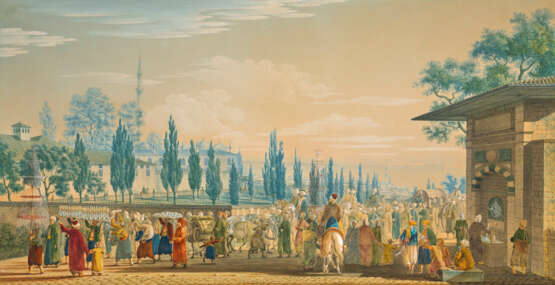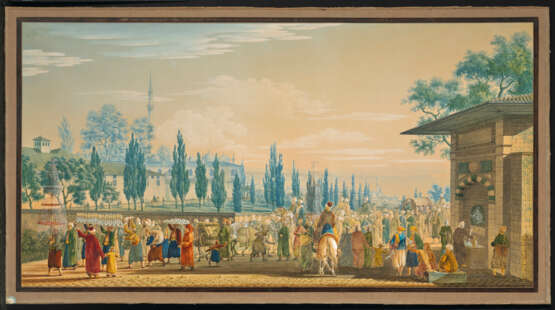ID 922073
Lot 74 | ANTOINE-IGNACE MELLING (KARLSRUHE 1763-1831 PARIS)
Valeur estimée
€ 200 000 – 400 000
Procession en l’honneur d’un mariage turc
graphite, aquarelle et gouache, rehaussé de gomme arabique, probablement dans son montage d’origine
42,2 x 81,4 cm (16 5/8 x 32 in.)
Provenance
Baron Eugène (1876-1929) et Baronne Marie-Cécile Fould Springer, palais abbatial de Royaumont, Asnières-sur-Oise, d’où acquis par Auguste (1862-1921) et Yvonne Boppe, née Prévost, puis par descendance au propriétaire actuel.
Literature
J. Perot, ‘Un artiste lorrain à la cour de Selim III: Antoine-Ignace Melling (1763-1831)’ Société de l'Histoire de l'Art Français, 7 février 1987, p. 140, note 20, ill (détail), p. 137.
A. Boppe, Les peintres du Bosphore au XVIIIe siècle. Collection Les orientalistes, vol. 8, Paris, 1989, pp. 244-248, ill. p. 288.
A. Mézin, C. Vigne, Les Français à Constantinople de François 1er à Bonaparte, Paris, 2020, p. 176-177, ill.
Exhibited
Amsterdam, Rijksmuseum, Paris, musée Carnavalet, Du Bosphore à la Seine, Antoine Ignace Melling, artiste voyageur, 1992, p. 25.
Le Havre, Musées historiques de la ville, Graville, Maison de l’Armateur, Magie du Bosphore ou le rêve d’Orient au XVIIIe siècle, 2010, n° 56.
Post lot text
ANTOINE-IGNACE MELLING, THE PROCESSION OF A TURKISH WEEDING, GRAPHITE, WATERCOLOUR AND BODYCOLOUR HEIGHTENED WITH ARABIC GUM
A masterpiece of Orientalist art, this large watercolour with shimmering colours, representing the a Turkish wedding in Pera, a district surrounding the ancient coastal city of Galata and facing Constantinople, was painted by the Lorraine artist Antoine-Ignace Melling during his stay in the Orient.
An artist at the service of the Ottoman Empire
In Constantinople, where he arrived in 1784 and stayed for eighteen years, Melling frequented artistic, cultural and diplomatic circles. It seems that he met his compatriot, the artist Jean-Baptiste Hilaire, the Russian ambassador to Constantinople, Yakov Bulgakov (1743-1809) for whom he worked very briefly, the Count Choiseul-Gouffier (1752-1817), French ambassador to the Ottoman Empire from 1784 to 1817, and Baron Frederik von Hübsch, the Danish ambassador in Constantinople, for whom he designed a superb garden at Buyuk-Déré. It was while visiting these gardens that Sultana Hatice, half-sister of the Ottoman Empire’s Sultan Selim III (1761-1808), hired Melling’s services for everything concerning the architecture, gardens and decoration of her palace (J. Perot, ‘Du dessin à la gravure. Le voyage pittoresque de Constantinople et des rives du Bosphore’, in Du Bosphore à la Seine. Antoine-Ignace Melling, artiste voyageur, exhib. cat., Paris, Musée Carnavalet, 2010, pp.18-19). The present watercolour discreetly reminds the viewer of Melling’s patron, the Sultana, and especially of her brother, in an inscription affixed to the fountain at the far left of the composition representing the calligraphic emblem of the sultan’s authority, the tughra.
Le Voyage pittoresque de Constantinople, an ambitious publishing project
This impressive watercolour, full of details, was engraved and published as plate 19 in 1809 in the Voyage pittoresque de Constantinople et des rives du Bosphore (fig. 1) after Melling’s return to Paris. This publication offered him a very high visibility upon his arrival in France and actively participated in his rapid integration into the Parisian artistic milieu. A large-scale editorial project, the work is a true survey of Constantinople at the time of Selim III, combining landscapes, monuments and scenes of local life. Melling conceived all the illustrations on the scale of the present watercolour, and was also actively involved in the conception of the work by closely supervising the realisation of the prints (J. Perot, op. cit., 2010, p. 40).
From sketch to watercolour
The drawing is described very precisely by Charles de Lacretelle in the Voyage pittoresque de Constantinople in these terms: ‘The procession is opened by a man who carries an enormous stick in pyramidal form, which crosses five boards from each of which descend long threads of gold foil which represent sheaves of wheat; it is a sign of the abundance that is wished to the two spouses. Then come two men carrying on their heads large trays loaded with vases full of flowers; a jester with his pointed hat dances and sings tunes in honour of the hymen; he has in his hand a handkerchief that he shakes and a caduceus whose bells he shakes as well. The person who comes next leads the sheep that is offered as a sacrifice to the bridegroom, the pieces of which are to be distributed to the poor. Then comes the bride’s trousseau and the closed chariot of the bride herself, which is led to the groom’ (De Lacretelle, op. cit., under pl. 19).
The landscape represented in the background was the subject of a preparatory drawing in graphite of great architectural precision in a great private collection (fig. 2), which was squared for transfer onto the present sheet According to an inscription at the top right of the sheet, this sketch was made from the artist’s window in Pera. Of this series of large watercolours depicting Turkish daily life, several are known today, most of which have passed into the art market. These include View of the seraglio in Constantinople (Sotheby’s, Paris, 29 October 2008, lot 6), Caics in front of the square and barracks of Top-Hane (Hôtel Drouot, Paris, 18 Jun 2012, lot 158), and a View of the Bosphorus taken at Kandilly (Hôtel Drouot, 18 June 2012, lot 159).
A work with a prestigious provenance
The watercolour under discussion, measuring no less than eighty centimetres wide, is considered one of the most representative Orientalist works of the late 18th century. The work belonged to the collection of Baron Eugène and Baroness Marie-Cecile Fould Springer, who resided at Royaumont abbey in Asnières-sur-Oise before entering directly into the collection of Auguste Boppe (1862-1921), French ambassador to Constantinople. He published several works on the history of the Ottoman Empire, including Les Peintres du Bosphore au XVIIIe siècle, published in 1911 and still a reference today thanks to an illustrated 1989 reedition. The watercolour has remained with the descendants of this diplomat since then and reappears on the art market today after more than a century.
Fig. 1. After Antoine-Ignace Melling, A Turkish wedding ceremony, etching.
Fig. 2. Antoine-Ignace Melling, View of the Bosphorus from Pera. Private collection, collection.
| Adresse de l'enchère |
CHRISTIE'S 9 Avenue Matignon 75008 Paris France | ||||||||||||||
|---|---|---|---|---|---|---|---|---|---|---|---|---|---|---|---|
| Aperçu |
| ||||||||||||||
| Téléphone | +33 (0)1 40 76 85 85 | ||||||||||||||
| Fax | +33 (0)1 40 76 85 86 | ||||||||||||||
| Conditions d'utilisation | Conditions d'utilisation | ||||||||||||||
| transport |
Service postal Service de messagerie ramassage par vous-même | ||||||||||||||
| Modes de paiement |
Virement bancaire | ||||||||||||||
| Heures d'ouverture | Heures d'ouverture
|




